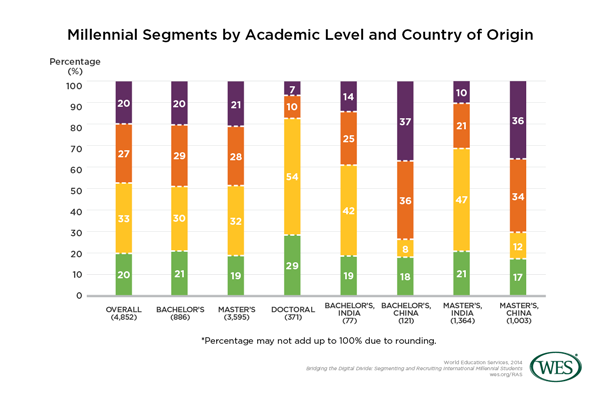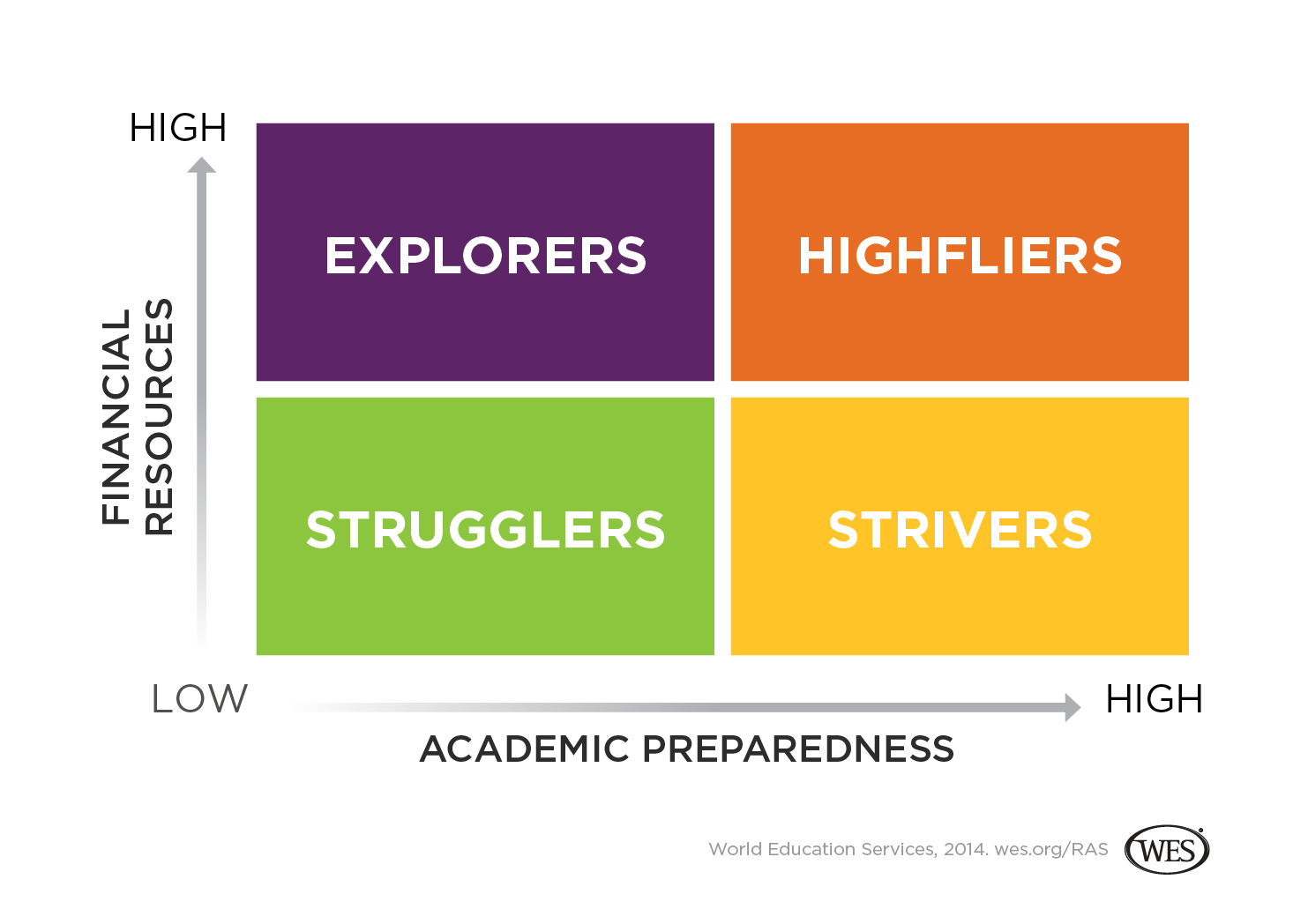Li Chang, WES Research & Advisory Services, Paul Schulmann, WES Research & Advisory Services, Zhengrong Lu, WES Research & Advisory Services
More than nine out of 10 Instagram users [1] are under the age of 35; nearly 85% of Facebook users in India [2] are between the ages of 16 and 34. Millennials worldwide—those born approximately between 1980 and 2000—have introduced a raft of new challenges and also opportunities to the field of international student recruitment. With regards to technology usage, Millennials differ from previous generations by:
- Communicating differently. Millennials (24%) are twice as likely as Gen X (12%) [3], the generation born from the mid-1960s through approximately 1980, to cite technology use as a unique attribute of their identity; 83% of Millennials sleep with their cell phone nearby as compared to 68% of Gen X. Also, their digital activities make it easier to connect with peers and the world at large.
- Influencing each other. Millennials worldwide are defined by their openness and willingness to share their opinions and experiences with their peers, whether they personally know them or not. This variety of social connection and involvement has earned them the moniker “alpha-influencers [4].”
To help higher education institutions (HEIs) understand and adapt to international Millennials’ information needs and behaviors, WES surveyed 4,852 U.S.-bound prospective international students between the ages of 17 and 36 years. The survey was conducted from October 2013 to March 2014. The respondents are international degree-seeking applicants to bachelor’s, masters’ and doctoral degree programs, hereafter, referred to simply as bachelor’s, master’s, and doctoral students.
Building on our first report [5], we delve further into the information-search journey of international students by exploring their use of technology and the psychographic characteristics that fundamentally influence their information-seeking behaviors. We also examine closely students from China and India at both the bachelor’s and master’s levels (See Section 3 for detailed discussion in the full report [6]).
Based on the segmentation of two dimensions: financial resources and academic preparedness (See Methodology in the full report [6]), we identified four segments of international students—Explorers, Highfliers, Strivers, and Strugglers—as follows:
Four International Student Segments
Explorers: Students with high financial resources and low academic preparedness
Highfliers: Students with high financial resources and high academic preparedness
Strivers: Students with low financial resources and high academic preparedness
Strugglers: Students with low financial resources and low academic preparedness
 [8]
[8]
Digital Life
A study from Pew Research Center [3] highlights that Millennials are twice as likely as Gen X to cite the use of technology as an attribute that distinguishes them from other generations. With this in mind, the findings of our survey are relevant for institutions that want to utilize technologies in their outreach efforts to more effectively target particular student segments or to differentiate their marketing outreach by degree level (See Section 2.1 in the full report [6]).
- International students consume more information online than they produce. Nine out of 10 respondents (90%) reported that they had read or browsed a social networking site, micro-blog, or discussion forum at least once in the past 24 hours before responding to the survey, as compared to three-fifths (61%) that actually contributed content.
- Mobile devices play a bigger role in the life of Highfliers than other segments. Overall, students with high financial resources are more likely to own a tablet. Forty-nine percent of Highfliers and Explorers own a tablet versus 35% of Strivers and 36% of Strugglers. Highfliers are the most likely to “strongly agree” that they like to keep up with the latest technological devices and gadgets with 41% reporting so as compared to 33% of all respondents.
- Strivers are more wired to the digital world. Not only are Strivers more likely to check, read and send email (66%), or check social networking sites (41%) several times a day than other segments, they are also the most likely to report having over 500 friends or connections (30%) on social networking sites compared to only 17% of Explorers.
Information Search Journey
Living in the world of technology has fundamentally changed the way Millennials search for schools. We find that differences in the use of information channels manifest in interesting ways across academic levels and student segments (See Section 2.2 in the full report [6]).
- While a personal computer is utilized the most during the information-search process, a majority of students use their smartphones as well. Almost all (91%) respondents used a personal computer during the U.S. college/university search process. More than half (56%) used a smartphone, and one in four used a tablet (26%), suggesting opportunities for institutions to facilitate the application process by being compatible with multiple platforms.
- Master’s students prefer word-of-mouth endorsements, particularly via smartphones and tablets. Master’s students are the most likely to use online discussion forums (27%) to research information on studying in the U.S., compared to 14% of bachelor’s students and 17% of doctoral students. Twenty-three percent of master’s students use social media to learn more about studying in the U.S., while 49% of those who have used a mobile device during the college-search and application process used it to connect with current students on social media, as compared to 37% of bachelor’s students.
- Strivers make good use of what is available to them. Consistent with their digital engagement, Strivers report greater usage of most of the available information channels, especially online, than other segments. Examples include: social media (27%) and virtual education fairs (7%).
Not only do students differ by level and segment in terms of how they prefer to retrieve and receive information, but they also differ by the types of information they seek. Using the best information channels to reach out to international students is important, but it must be accompanied by quality, tailored content (See Section 2.3 in the full report [6]).
- Information on tuition and fees as well as student services is critical to bachelor’s students. Four-year bachelor’s programs usually cost more out-of-pocket than masters’ programs that typically take two years or less to complete. As a result, bachelor’s students are more likely to select tuition and cost of living as one of their top three information needs (38%), compared to 32% of master’s students. They are also the least likely (11%) to consider faculty research and expertise as a pressing information concern. Bachelor’s students (20%) are much more interested in information about student services including campus safety and student life, nearly twice as likely as master’s students (11%) and three times as likely as doctoral students (7%).
- Information needs differ by segment. Highfliers are more reputation-conscious than their peers; 48% of them selected information about an institution’s reputation as one of their top three information needs. Explorers (39%) are more than twice as likely as Strivers (18%) to choose location as a top three information need. Similar to Strugglers, Strivers (40%) are more likely to seek information related to financial aid and scholarship opportunities as one of their three top information needs than their financially better-endowed counterparts, Highfliers (13%) and Explorers (11%).
Influencers of Application Decision
Our research indicates that a university network comprised of faculty, admissions officers, current students and alumni has the biggest influence on students during the application process, followed by students’ families.
- A university network has the largest influence. More than two-fifths of respondents (42%) cited a university network as being the most influential in regards to their decision of where to apply. In particular, 44% of master’s students chose the university network as compared to 33% of bachelor’s students.
- Family matters. Following the university network, family is the second most influential group and has more influence on younger students—41% percent of bachelor’s students cite family as the biggest influence on their study abroad decisions, compared to 32% of master’s students and 28% of doctoral students.
In this context, the ability to leverage prospective students’ network becomes very important; institutions need not only to convey their value proposition to students, but also those relations who could potentially influence a student’s application decisions (See Section 2.4 in the full report [6]).
Psychographics Characteristics: Motivation, Value of Education and Success
Overall, the most cited reason for wanting to pursue higher education in the U.S. is the desire to expand career and life opportunities. Seventy-nine percent of respondents selected this as one of their top two reasons. As found in previous years, Highfliers and Strivers are more motivated to study in the U.S. because of the country’s reputation for high quality education and the prospect of expanding career opportunities. Conversely, Explorers are more motivated by the experiential aspects while Strugglers are more motivated by the possibility of financial aid and the opportunities to have new life experiences (See Section 2.5 in the full report [6]).
Finally, our survey highlights the attitude of international Millennials towards education, success, and other factors. This is pertinent information for institutions wishing to understand the fundamental values underlying student behavior, and wanting to reflect the relevant themes into their value proposition strategy (See Section 2.6 in the full report [6]).
- Higher education is a direct avenue for achieving success in today’s workforce. Thirty-five percent of Highfliers and 33% of Strivers “strongly disagree” that they can succeed in today’s workforce without a college/university degree, versus 25% of Explorers and 28% of Strugglers.
- A U.S. diploma is not the only path to success. Overall, only 8% of respondents “strongly agree” that they have to study at a U.S. college/university to achieve their career goals. Although recognizing the value of higher education in helping them succeed, the respondents are less likely to think that the pathway lies only in the U.S.
- Earning potential doesn’t define a person’s success. Despite their academic success and career aspirations, Highfliers and Strivers are less likely to assess career outcomes and success in strictly financial terms compared to Explorers and Strugglers. Twenty-four percent of Highfliers and Strivers “strongly disagree” that they tend to measure a person’s career by how much he or she earns, as compared to Explorers (14%) and Strugglers (17%).
Recommendations
To achieve effective and informed international enrollment strategies, we recommend that HEIs adopt evidence-based practices to better understand the constantly changing needs and behaviors of international Millennial students. One such change is the use of digital technologies among international Millennial students in their study-abroad decision-making processes. With this in mind, we recommend that HEIs:
- Adapt to students’ technology usage. Fifty-six percent of Millennials used a smartphone to search for and apply to U.S. colleges or universities, suggesting mobile devices play a large role in their prospect-to-application journey. It is recommended that HEIs devise a digital strategy, for example, making websites more mobile-friendly.
- Embrace the power of network marketing. A collective university network exerts the biggest influence on Millennials’ decision-making processes regarding which colleges or universities to apply to. Admissions officers, faculty, current students and alumni comprise a cohesive university network. HEIs need to form strategic relationships with these stakeholders and have them interact with prospective students via digital technologies.
- Tailor content to communicate your institution’s value proposition to students. Despite being active in the digital world, international Millennials are more likely to consume online content than produce it. This highlights the importance of an institution’s role in generating relevant, quality content to engage with this audience.
In a climate of decreasing budgets and increasing pressure to recruit students from abroad, reassessing your recruitment strategies and adapting them to the needs of your target audience is the best way to ensure a good return on investment for your recruitment efforts.

